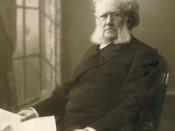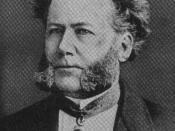Henrik Ibsen was born in Skien, Norway, on March 20, 1828. He was the oldest of five children. His father, Knud, was a prominent merchant, but he went bankrupt when Henrik was eight years old. Thus, Henrik Ibsen lived in poverty from a very young age. From 1851 to 1864, he worked in theaters in Bergen and what is now Oslo (then it was called Christiania). In this work, he was not financially well off, but he did gain valuable experience. In 1858, Ibsen married Suzannah Thoreson and had one son with her. Ibsen's critics attacked him for failing to respect marriage's "sacred ties." Ibsen felt that, rather than merely living together, husband and wife should live as equals, free to become their own human beings. The 1850s, when Ibsen was working in theater in Norway, were a very idyllic time for the nation, in contrast to the rest of Europe.
Ibsen's writings however, tended to stir up society and its emotions. This led him to a separation from Norwegian society. Ibsen received a traveling grant and a stipend from the Norwegian government to go abroad in 1864. He permanently moved to Rome and so it was there that he wrote "A Doll House." It was first published and performed in 1879, by which time Ibsen had long been interested in women's rights. Ibsen died in 1906 (Westhagen).
"A Doll House" is classified under the "second phase" of Henrik Ibsen's career. It was during this period, which he made the transition from mythical and historical dramas to plays dealing with social problem. It was the first in a series investigating the tensions of family life. Written during the Victorian era, the controversial play featuring a female protagonist seeking independence stirred up more controversy than any other of his works...



Good essay
The introduction should be stronger and more appealing to the reader so that some one would want to read it.
0 out of 0 people found this comment useful.